|
Thomas Grenier
Mary Grenier
Volney Grenier |
|
That the following entry on Thomas and Mary Grenier is
easily the longest in the book is not due to family
pride on the part of the researcher. Rather, it is
intended to give the reader a more comprehensive
understanding of what our pioneers in pre- and
post-Separation Queensland endured when they left their
homes overseas and began a new life on the other side of
the world. It is also fitting that we recognise the
unique link that Thomas and Mary had to the place we
commonly call God’s Acre. What is now their last resting
place was once part of the fields they surveyed from
their home and that they cultivated with hard and
persevering work. A much fuller account of their life
and times may be read in this writer’s Thomas and
Mary Grenier: Brisbane Pioneers, Brisbane, 2002.
Thomas Grenier,
one of our pre-Separation pioneers, was living in
Kororareka (present day Russell) on New Zealand’s Bay of
Islands when he heard that the first sale of land in the
Moreton Bay Settlement would take place by auction in
Sydney on 14 July 1842. He crossed the Tasman and,
having made a successful bid of £31 for Allotment 14 in
Section 1, travelled north on the 200-ton steamer
Shamrock to inspect it and to survey the scene. This
36-perch block stood in Grey Street directly opposite
what is now the entrance to the South Brisbane Railway
Station.
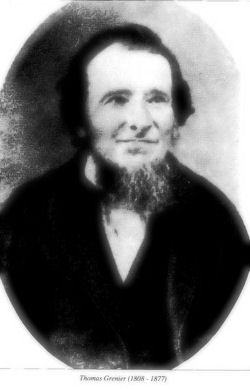
On his return to New Zealand Thomas was able to tell his
family that their future was a little more secure in the
event that a Maori uprising should make life too
difficult for them. For the most part, the Maoris
related well with the settlers; but their implacable
opposition to the British military presence was a
constant source of friction.
This problem came to a head when Hone Heke and his ally,
Te Ruki Kawiti, sacked and torched the township on 11
March 1845, leaving only the Anglican church and the
residence of the Catholic bishop undamaged. Thomas and
Mary and their six young children fled to Auckland on
the British whaling vessel Matilda and sought
refuge with Mary’s sister and brother-in-law, Eliza and
Alexander Smart Martin. The Martins had travelled to New
Zealand with the Greniers but had left Kororareka
towards the end of 1842.
Intent on giving his family a new beginning, Thomas
disposed of the properties he had bought in Auckland’s
first land sale in April 1841 and returned to Brisbane
before the year was out. In the six months that elapsed
before his wife and children could join him, he built a
modest dwelling on the Grey Street property. To support
himself he opened a butcher shop in Queen Street on the
site of what is presently Hungry Jack’s, not far from
where Patrick Mayne operated a similar business. Given
his childhood background, his choice of occupation and
his preference for self-employment were hardly
surprising.
Thomas Grenier, the son of Thomas and Martha (née
Hamper) Grinyer, was born into a family of shopkeepers
in Brighton, Sussex, on 4 July 1808. That he was
independent in outlook and adventurous in spirit is
evident in the fact that he crossed the Atlantic while
still in his teens and backpacked, as we would say
today, travelling by riverboats, stagecoaches and on
foot for 18 months around the eastern part of the United
States of America. He celebrated his 21st
birthday there on Independence Day 1829.
On his return to Brighton, Thomas resumed work in the
family grocery business; and on 15 November 1832 he
married Portsmouth-born Mary Pannell, the eldest
child of George and Jemima (née Clark) Pannell, in the
Church of St Nicholas. By a strange quirk of fate,
Thomas and Mary’s first child, Ann, died on 10 September
1834—the very day on which their second daughter, Mary
Ann, was born. Two other children, Eliza and Sarah, were
added to the family before Thomas and Mary decided to
emigrate to Melbourne, Australia.
Having said farewell to their circle of friends and
relatives, they departed from St Katharine’s Dock in
London on 1 October 1838 as steerage passengers on board
the 658-ton barque Perfect under the command of
Captain William Snell. Four months later on the evening
of Thursday, 31 January 1839 they entered Sydney
Harbour. Thomas used their stopover to good advantage by
purchasing at an auction in Sydney’s Market Building an
inner-city Melbourne property. He sold it at a very
considerable profit soon after the family’s arrival
there two months later.
Believing that their prospects would be better in New
Zealand, the Greniers, by then seasoned travellers, set
sail on the 350-ton Earl Stanhope in late
February 1840. The 1,700-mile journey must have been
especially trying for Mary who, still only 26 years of
age and pregnant with her fifth child, gave birth to
Thomas Jr on 31 March just as the ship docked at Port
Nicholson (Wellington). A few weeks later the family
settled in the North Island in Kororareka (present day
Russell) where Thomas worked as a carpenter and erected
two houses—one for his family and one for the
above-mentioned Martins.
Space prevents a detailed account of the life that
Thomas and Mary Grenier lived in the four years leading
to the sacking of the town by the Maoris. We need only
add that they were blessed with two more sons, Volney
and George Alexander, both of whom, together with their
sister Eliza and their parents, would one day be laid to
rest in God’s Acre at Cooper’s Plains.
A terrifying storm and the constant care of her six
young children ensured that Mary Grenier’s return voyage
across the Tasman, this time on the small two-masted
schooner Harlequin, was even more eventful than
her first. However, having made the last leg of the
journey safely from Sydney on the Sovereign, the
children and their mother were reunited with Thomas on
21 September 1845 and settled into their newly-erected
house. A new chapter in the family story was about to
begin.
Brisbane was hardly a thriving metropolis at that time.
The population statistics, based on the census of 2 May
1846, indicate that there were only 614 non-indigenous
inhabitants in North Brisbane (405 males and 209
females) and 346 in South Brisbane (209 males and 137
females). Indeed, when Thomas Grenier’s name first
appeared on ‘the electoral list for the Town of
Brisbane, District of Moreton Bay, County of Stanley’,
he was one of a mere 75 eligible to vote.
Writing in his diary about two months after the Greniers’
arrival, Thomas Dowse, the former convict who became
Brisbane’s second Town Clerk and a close family friend,
observed: ‘Brisbane is the dullest of all dull
settlements at this part of the year. Innkeepers,
Storekeepers are about as well off as Hutkeepers’.
Whether or not Thomas shared these views, he continued
to conduct his butcher’s shop in Queen Street until May
1848 when George Poole took over the premises as a
‘chemist, druggist and family grocer’.
In September of that year he successfully applied for
the licence of the Brisbane Hotel which had been built
by the astute businessman Evan Mackenzie near the
south-western corner of the intersection of Russell and
Grey Streets. Thomas was the third licensee of this
establishment, having succeeded Robert Rowland and Jacob
Goode. The latter is remembered as the man who, in a fit
of frustration, pushed the ferryman John William
Christie overboard because he delayed a crossing of the
Brisbane River in the hope of obtaining more passengers.
The hotel became popularly known as ‘Grenier’s Inn’—a
designation which endured long after Thomas had
relinquished the licence in 1858 in favour of his
daughter-in-law’s widowed mother, Mary Greenwood. An
anonymous author wrote of the hotel in these terms in a
ballad entitled ‘Way back in Fifty-Nine’:
But we have prophets here who
dream
That ships with steam and sails
Will come right up to Grenier’s Inn,
In Brisbane, New South Wales.
A ‘social centre and a Brisbane landmark in the [18]40s
and 50s’, the hotel was a ‘favourite house of call for
squatters’ from the Logan, the Downs, the Dawson and the
Burnett who, as Thomas’s obituarist observes, ‘were
alike in appreciating the comfortable and lively old
English style in which … Mrs. Grenier and her three
attractive daughters conducted the hostelry’. It was one
of the preferred ‘watering holes’ of the well-to-do
Nehemiah Bartley who, looking back in 1892, describes it
in his book Opals and Agates as a ‘well-kept and
highly patronized hotel’. ‘George Harris and I often
strolled up to Grenier’s in the evening,’ he writes,
‘for there was more “life” there than at any other hotel
in town’.
Capturing something of the egalitarian spirit and
bonhomie that prevailed in Grenier’s Inn in those days,
Bartley also writes of a practical joke played on
Captain Thomas Collins of Telemon Station, a regular
patron of the hotel.
Fun there was, in plenty, in those days … All innocent
fun; but there was real mischief at work when some
unknown fiend packed all the spoons, knives, and forks,
from Mrs. Grenier’s public breakfast table, into old
Captain Collins’s valise, already half full of clean
shirts, just before that unconscious gentleman started
home to the Logan. Mrs. Grenier thought the blacks had
stolen them, and had their camp searched in vain. The
mystery was solved when, a fortnight later, the captain
came to town again, and threw the articles on to the
verandah, with some of that figurative language,
peculiar to elderly sea captains. The real culprit was
never discovered, or nobody knows what might have
happened. But, old Collins stayed there, the same as of
yore, for it was all taken in good part in those days,
and there was a feeling of old friendship between
landlord and guest, then, which is all out of date now.
Managing a hotel in mid-19th century Brisbane
was no easy task in an area where the unsealed streets
were often in appalling condition owing to poor drainage
and the daily traffic of horses and cattle. Good
stabling and suitable feed had to be on hand for the
patrons’ highly prized horses. Clean linen, laundered in
wood-fired coppers, had to be provided for beds and
tables. Hearty dinners had to be prepared on wood stoves
for weary travellers and served in poorly lit dining
rooms. Adding to the publican’s many preoccupations (as
Thomas sometimes found to his cost) were laws which,
among many other regulations, required that patrons
should be admitted to the hotel only through the doorway
fronting the public street, that forbade music and
dancing and the playing of card games on the premises
and that prohibited the serving of alcohol to aborigines
even when as stockmen they were occasionally clients of
the hotel.
But these heavy demands did not stop Thomas from taking
an active part in the social, civic and recreational
life of early Brisbane. His name appears on several
petitions or memorials in support of initiatives as
diverse as Separation from New South Wales, the
establishment of the Moreton Bay Hospital where the
Supreme Court building stands today, the development of
water resources on a government reserve at South
Brisbane, the provision of a post office on the southern
side of the River, the retention of a military presence
in the colony to assist in maintaining law and order,
and the conduct of ‘a survey of the River Brisbane with
a view to its being deepened’.
A perusal of the subscription lists published in the
Moreton Bay Courier will reveal that he was a
frequent and fairly generous contributor to worthy
causes at home and abroad. Ensuring that such support
would extend even beyond his demise, he included among
the beneficiaries of his will three organisations that
had been recipients of his practical assistance during
his lifetime—the South Brisbane School of Arts (of which
he had been the treasurer and the vice-president), the
Acclimatisation Society at Bowen Park and, interestingly
for a publican, the temperance body known as the Good
Templars Society.
In the decade leading to Separation there were several
additions to the family—Henry and Franklin1,
both of whom died as infants, Henry John, Franklin2
and William Leichhardt. Two other sons, both of
whom had been born in New Zealand, died during this
period—Thomas Jr who was buried in the Church of England
section of the old Paddington Cemetery and Volney of
whom more below.
The establishment of the Brisbane Municipal Council on
13 October 1859 enabled some of the young colony’s
influential businessmen to take a more active part in
the development of the town. Thomas Grenier stood
unsuccessfully for election in February 1865. Undaunted
by this loss, he tried again two years later and became
one of the two representatives of the South Ward. His
first term of office was served under Albert John
Hockings and his second under John Hardgrave. Council
minutes reveal that he served on various committees and
that, mindful of the recurring complaints of his
constituents, he took a special interest in improving
the drainage and roads in South Brisbane. During those
years the versatile Thomas Dowse, a former convict, was
the Town Clerk, having succeeded William Martin Boyce
whose grandson WFR (Frank) Boyce, married Thomas
Grenier’s grand-daughter Minnie Kate Jessie Benn.
After the Greniers had settled permanently in Australia,
Thomas continued to buy land. There was probably a
speculative element in some at least of these purchases;
but it is more likely that, looking to the future, his
prime concern was to provide for the needs of his
children. Between March 1853 and June 1868 he often
attended auctions of government land and bought property
in what are presently the suburbs of South Brisbane,
West End, Woolloongabba, Highgate Hill, Balmoral, East
Brisbane, Sandgate, Shorncliffe, Yeerongpilly and
Archerfield, and further afield in Toowoomba (Drayton)
and Ipswich. He also leased extensive tracts of land for
pastoral purposes.
The most significant of these purchases was made on 31
May 1855 at an auction in the Brisbane Court House. The
fact that Thomas paid £3 per acre for the 640-acre
Portion 18 (Yeerongpilly), for which the upset price was
only £1 per acre, indicates that the bidding must have
been very keen. Even though he was still a South
Brisbane publican at this time, Thomas and his sons with
the assistance of employed labour set about developing
this area (presently occupying much of Archerfield
Airport) as a grazing property and dairy farm. In the
months leading up to Separation he expanded these
activities to include the breeding of quality horses and
mares.
In 1861, feeling the need for an additional source of
income, Thomas decided to entrust the management of the
family farm to his eldest son George Alexander and to
open a grocery, wine and spirit store in South Brisbane
next door to the Brisbane Hotel. Apparently, his
financial situation continued to leave something to be
desired as he made a serious effort to dispose of his
large Cooper’s Plains property. However, despite a
series of advertisements in the Brisbane Courier
in 1862, he failed to secure a suitable buyer and the
farm remained in his possession until his death in 1877.
By then it had been subdivided by the licensed surveyor
William Cowley into six blocks, five of which Thomas
willed to his sons George Alexander, William Leichhardt
and Franklin Grenier.
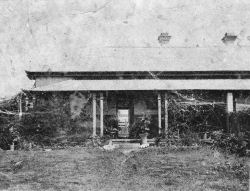
He left subdivision 6, a small area of 3 roods, ‘in
trust for the purpose of a Burying Ground for members of
[his] own family or any other persons they may think
proper’. He also gave and bequeathed to the trustees of
his last will and testament ‘the sum of fifty pounds in
trust for the purpose of making or keeping in repair the
Gates and Fences to the said Burying Ground’. The first
burial at this site had taken place on 27 October 1859
when Thomas and Mary’s 16-year-old son Volney was laid
to rest. Between that day and 16 July 1980 when Olive
Grenier, the youngest of their 41 grandchildren, was
buried there, the mortal remains of about 180 people
were committed to the earth in what has become popularly
known as God’s Acre. Each year since 1991 on the last
Sunday of June descendants of those buried there have
assembled mid-morning in the cemetery grounds to
remember the dead, to share family stories and to enjoy
a picnic together. In conjunction with the observance of
the 150th anniversary of Queensland’s
statehood in 2009, celebrations are currently being
planned to mark the sesquicentenary of the first burial.
Historians are not much given to assessing the character
and temperament of the people they write about,
preferring to let the recorded facts of their lives
speak for themselves. That will not deter the present
writer from referring to a few events in Thomas
Grenier’s life which are revelatory of the man. That he
was protective of his children is evident in the
impulsive action he took in May 1850 when his daughter
Eliza was severely bitten by an unrestrained dog
belonging to a rival publican John McCabe. Having
derived no satisfaction from his altercation with the
dog’s owner, Thomas shot and killed the animal. Both
parties to the dispute presented their versions of the
facts in well-written paid-for advertisements in the
Moreton Bay Courier.
The same concern extended to his employees at the hotel,
among whom were represented English, Irish, German,
Chinese and aboriginal workers. On one occasion, wishing
to see justice done, he caused a police constable to be
arraigned before the police magistrate and subsequently
dismissed from the force for assaulting Billy Harris, an
aborigine in his employ. Hospital records indicate that
he also met the hospital expenses of needy people, some
of whom probably worked for him.
Thomas Grenier’s name has been assigned to four streets,
a lane and a park in Brisbane and to a street in
Toowoomba. There are also four streets in close
proximity in West End where he owned several properties
which have clear associations with his family. His
principal memorial, however, is the tribute his children
had inscribed on their parents’ gravestone which holds
pride of place in God’s Acre:
In Loving Memory Thomas Grenier Who departed this life
October 7th, 1877, aged 69 years.
Also his beloved wife Mary, March 2nd, 1876,
aged 62 years.
This table is erected by their children.
The deceased were amongst the earliest settlers of the
colony and were highly esteemed
by many of the old residents of Brisbane,
as well as by the distinguished pioneers who took an
active part in the development of Queensland.
In their domestic relations as parents, they commanded
the affections of their children,
and as citizens the respect of all who came in contact
with them.
After journeying together through life for forty years,
they now rest in peace side by side.
Mary Grenier’ burial, witnessed by two family friends,
Henry Lucock JP and William Huet, took place on 3 March
1876, the day after her death. Thomas himself acted as
the undertaker.
On 7 October 1877 Thomas Grenier died and was laid to
rest beside his wife. His son Henry John acted as
undertaker and the Reverend James Samuel Hassall of the
Church of England performed the graveside service in the
presence on Henry Lucock JP and William Huet
(witnesses), both of Oxley. The latter gentleman was
also one of the two witnesses of Thomas’s last will and
testament.
Volney Grenier
was born in Kororareka (now Russell) on the Bay of
Islands, New Zealand, on 7 July 1843 and was christened
in the local Christ Church on 3 August 1843 by the
Reverend Robert Burrows. It was there that the same
pioneering Church of England clergyman had earlier
baptised Volney’s brothers, Thomas Jr and George
Alexander, and his cousin Sarah Eliza Martin.
The origin of his unusual given name, which appears
nowhere else in the family tree prior to 1843, has yet
to be established. Thomas Grenier may have come across
it when travelling in the eastern part of the United
States in 1828-29. In Oswego County in New York State,
at the south-eastern end of Lake Ontario, there is a
town called Volney, after which (as records indicate) a
number of local people have been named.
Volney died on his parents’ farm at Cooper’s Plains on
26 October 1859. A long-standing Grenier tradition,
commonly accepted by historians but unsupported by any
documentation known to the writer, is that he succumbed
after sustaining serious injuries in a fall from a horse
on the family property. Volney’s death certificate (No.
390—registered by the Reverend Robert Creyke) states
that he died from chronic peritonitis, endured for a
period of 15 days. It further indicates that his
birthplace was the Bay of Islands, New Zealand, and that
he had lived for ‘fourteen years in the Colony of New
South Wales’. His father’s occupation is given as
‘farmer’.
Volney was buried in God’s Acre, Cooper’s Plains, on the
day after his death—the first of the family to be
interred there. Joseph Wonderley, who married Volney’s
sister Sarah Grenier in May 1860, was one of the two
official witnesses to the burial. The signature of the
other is not easy to decipher; but it seems likely that
he was Alexander Fraser, a blacksmith and farrier whose
business was a stone’s throw from Grenier’s Hotel in
South Brisbane.
|
|
|
Franklin Grenier |
|
Franklin Grenier
(generally known as Frank) was born to Thomas and Mary
Grenier on 27 November 1851 when his father was the
licensee of the Brisbane Hotel in Russell Street, South
Brisbane. He was christened by the Reverend Henry Offley
Irwin in the original St John’s (the family’s preferred
church at that time) on 29 August 1852. Thomas’s
occupation is given in the baptismal record as
‘Inn-keeper’.
On Christmas Eve 1875 Frank Grenier married London-born
Ellen Henrietta Cayzer, the daughter of John
William and Ellen (née McGlynn or McGlinn) Cayzer, at St
John’s Church. The officiating clergyman on this
occasion was the Reverend John Sutton. They had no
children.
Frank, who had suffered from epilepsy for some years,
died on 5 January 1889 at his residence, ‘Franklin
Vale’, Cooper’s Plains, at the age of 37 years. Present
in an official capacity when he was buried near his
parents in the family cemetery on the following day
were: the Reverend James Samuel Hassall, William Francis
Lyons (undertaker), Edgar E Bletchley and H Pratten
(witnesses).
Eighteen months later, on 20 June 1890, Ellen married
Frank’s nephew, Thomas Leichhardt Grenier (the
eldest son of George Alexander and Sarah Mary Agnes
Grenier) in St Mary’s Church, Kangaroo Point. The
Reverend Herbert Heath presided at the wedding. This too
was a childless marriage.
Thomas and Ellen moved to Sydney where they resided at
576 Crown Street, Surry Hills. Ellen died there on 4
October 1914; and her remains were interred in the
Church of England section of Rookwood Cemetery. Thomas
Leichhardt Grenier passed away at Bargo in New South
Wales on 5 January 1927. His death was registered in
Picton (3001).
|
|
|
George Alexander Grenier
Sarah Mary Agnes Grenier |
|
George Alexander Grenier,
the son of Thomas and Mary Grenier, was born on 23
November 1841 at Kororareka, New Zealand, and was
baptised there on Christmas Day 1841 in Christ Church
according to the rites of the Church of England by the
Reverend Robert Burrows.
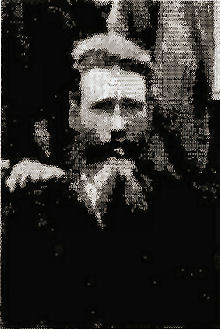
His working life was spent as a farmer on the 640-acre
family property, ‘The Willows’, (now in the suburb of
Archerfield)
which his father had purchased in 1855.
After Thomas Grenier’s death George inherited sections 2
and 3 of the estate, comprising just over 277 acres.
George Alexander Grenier’s marriage to Sarah Mary
Agnes Greenwood took place on 26 August 1863 in the
historic Church of St Stephen, in Elizabeth Street,
Brisbane, according to the rites of the Roman Catholic
Church. The Irish-born celebrant was the Reverend
Michael Patrick Renehan. The witnesses were family
friends, John and Annie (née Graham) Cockerill, born in
Surry Hills, Sydney, on 16 August 1845, Sarah was barely
eighteen on her wedding day. In her husband’s newspaper
obituary she is described as ‘one of the two beautiful
daughters of another very old colonist’. The same writer
observes that ‘Young Grenier and his wife were a
decidedly handsome couple’.

It could be that Thomas Grenier’s business interests
played a part in the courtship of George and Sarah. Her
father, James Greenwood, was a publican and for a time
was the licensee of Victoria Hotel in Queen Street, the
Prince of Wales Hotel on the corner of Charlotte and
Edward Streets, and the Queen’s Arms Hotel at Kangaroo
Point.
Like his three married sisters, George, a hardworking
farmer, became the parent of a large family—six sons and
two daughters. In order of birth they were: Thomas
Leichhardt (b. 10 June 1864; d. 5 January 1927), an
unnamed male child (b. 26 February 1866; d. 4 March
1866), George Alexander Jr (b. 23 March 1867; d. 7
August 1924), James Franklin (b. 31 January 1869; d. 6
April 1935), Mary May (b. 3 June 1871; d. 22 July 1946),
Sarah Lilly (b. 22 November 1873; d. 19 September 1928),
Ernest Pannell (b. 4 April 1876; d. 26 November 1943),
William Pannell (b. 29 July 1878; d. 9 December 1958),
and Reginald Courtenay (b. 27 February 1882; d. 3
November 1948). That there might have been an addition
to this list is indicated in a sad notice which appeared
in the Queenslander in June 1886: ‘GRENIER.–At
The Willows, Oxley, Mrs. G. A. Grenier, of a son,
still-born’.
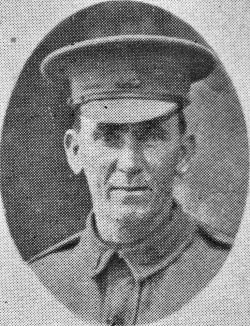
William Pannel Grenier
Of the above children the following were buried in God’s
Acre: James Franklin, Mary May (Cameron), Sarah Lilly
(Wallace), Ernest Pannell, William Pannell, and Reginald
Courtenay (ashes only). For additional information about
them, see the entries under their names.
George died at his residence at Cooper’s Plains on 4
March 1915 and was buried in the family plot in the
Cooper’s Plains Cemetery on the following day. Present
in an official capacity were: Abraham Hislop
(undertaker), the Reverend Edward Rooke (Church of
England minister), and George’s son-in-law Donald Stuart
Cameron and D Robinson (witnesses).
The following obituary appeared in the Brisbane
Courier:
A very old resident of Queensland, Mr. George Alexander
Grenier, of Roslyn, Cooper’s Plains, died at his
residence on Thursday last at the age of 74 years. The
deceased was only three weeks old [three years old, in
fact] when his parents came to Brisbane. His father (Mr.
Thomas Grenier) was born at Brighton, in Sussex. He and
his wife passed through some thrilling experiences in
New Zealand before they came to Moreton Bay in 1845.
Shortly after his arrival in Brisbane Mr. Thomas Grenier
became the host of probably the best-conducted hotel,
and also kept a store. Prior to Separation he retired to
The Willows Estate, Cooper’s Plains, which he purchased
from the New South Wales Government, and to the same
locality 52 years ago, his son, George Grenier, brought
his bride, formerly Miss Greenwood, and daughter of
another Moreton Bay pioneer. The family have ever since
resided in the locality. Mr. Thomas Grenier, who died in
1877, dedicated a block of land on his property for the
purposes of a cemetery, and there the remains of him and
his wife, and most of the deceased members of the
family, were laid to rest. The late Mr. George Grenier,
whose funeral took place yesterday, is survived by his
widow and several sons and daughters, including Messrs.
E. P. Grenier (Crown Lands Commissioner, Clermont), R.
C. Grenier (Clerk of Petty Sessions, Charleville), James
and William Grenier (Cooper’s Plains), Mrs. Cameron
(Sandgate), and Mrs. R. Wallace (Rosewood). The late
Mrs. Wonderly [sic], of Toowoomba, was a sister of the
deceased. During their occupancy of The Willows the
late Mr. George Grenier and his wife were noted for
their hospitality. Mr. Grenier took an interest in
horse racing, and Brisbane history, recently reprinted
in the “Courier” under the heading “Fifty Years Ago,”
told of some of his successes on the turf.
A similar obituary with some additional details appeared
in the (Brisbane) Truth:
The name of Grenier has frequently occurred in the
instalments of old Brisbane history now appearing in
“Truth,” and general interest in the family will be
further revived by the announcement of the death of Mr.
George Alexander Grenier, son of the late Mr. Thomas
Grenier, at his residence “Roslyn,” Cooper’s Plains, on
Thursday last. Mr. Thomas Grenier, the founder of the
family in the Moreton Bay district, was a native of
Brighton, Sussex. He and his wife were Britishers of
really good stamp. They came to Australia, and arrived
in Sydney in 1839, several years after their marriage.
Afterwards they went to New Zealand, but after the
destruction of their property in a Maori uprising, they
returned to Sydney, and in 1845 came to Moreton Bay and
established a highly reputable hotel in Brisbane, and
also kept a store, and later had an interest in several
boats engaged in the bay trade. [The researcher has
found no evidence for this interest]. The late Mr.
George Alexander Grenier, who was about 74 years of age
at his death, married in 1863 or thereabouts Miss
Greenwood, one of the two beautiful daughters of
another very old colonist. Young Grenier and his wife
were a decidedly handsome couple. Another notably
handsome member of the family was Miss Eliza Grenier,
who first became Mrs. Watson, and afterwards Mrs. Benn,
and died at the age of 37 years. This lady has received
special mention in Mr. Nehemiah Bartley’s “Book of
Recollections.” Mr. Bartley, who afterwards married a
sister of Sir Edmund Barton, unsuccessfully wooed Miss
Grenier, but his memories of her were so lasting that he
gave them literary endurance. Another daughter of Mr.
Thomas Grenier was the late Mrs. Wonderly [sic], of
Toowoomba. There were several other sons besides Mr.
George Grenier, who, like his parents and himself, were
buried in the private cemetery established by Mr. Thomas
Grenier at Cooper’s Plains. Mr. Thomas Grenier and his
family retired to the Willows Estate, Cooper’s Plains,
Oxley Creek, prior to Separation, and entered into
farming and grazing pursuits. The Grenier dairy, which
had a very large output, for a number of years supplied
the Brisbane Hospital. Mr. George Grenier and his wife
were extremely hospitable, and entertained many large
house parties at “The Willows,” which property
eventually passed out of the hands of the family, who,
however, have continued to live at Cooper’s Plains. Mr.
Thomas Grenier was honoured by the attachment of his
name to a street in Brisbane. On one tombstone in the
Grenier cemetery is a simple slab, with the following
inscription: “In affectionate remembrance of Thomas
Grenier…” [the inscription is given in full elsewhere in
our text].
Apparently the vigor of the family has increased rather
than decreased under the effects of the Queensland
climate. The late Mr. George Grenier was 74 years of age
at his death, and his widow at 70 years of age looks as
though she had [sic] many years still to go. Several
sons of the family hold important official positions;
others have remained on the land, not far from their old
home. The wife of Dr. R. Wallace, of Rosewood, and Mrs.
Cameron, of Sandgate, are daughters of the deceased.
|
|
Sarah Mary Agnes Grenier
survived her husband by nine years and continued to live
in the family home until a few months before her death
at the age of 78 on 27 May 1924. She died at
‘Gloucester’ in Russell Street, South Brisbane—the
residence of her elder daughter Mary May Cameron and her
commercial traveller son-in-law Donald Stuart Cameron.
Full of years and good works, Sarah was laid to rest
beside her husband. The funeral moved from the Church of
Mary Immaculate, Ipswich Road, Annerley on the afternoon
following her death. |
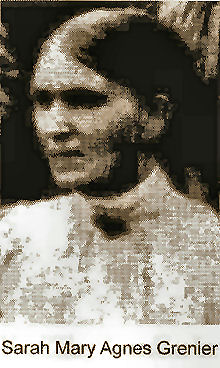 |
|
The following obituary of Sarah Mary Agnes appeared in
the Brisbane Courier:
An old resident of Brisbane, Mrs. Sarah Mary Grenier,
passed away at the residence of her daughter, Mrs. D. S.
Cameron, Russell-street, South Brisbane, on Tuesday, at
the age of 78 years. The late Mrs. Grenier was born at
Surry Hills, Sydney, and at the age of 14 she came to
Brisbane where her father, Mr. James Greenwood, took
over an hotel in Queen-street. Four years afterwards she
married the late Mr. George Alexander Grenier, one of
the early residents of this State. Until her husband’s
death she lived with him at The Willows, Oxley Creek,
near Rocklea, where he was a farmer. She met with the
usual experience of a pioneer in the early days, and was
widely known for her kindly hospitality. During the war
she took a prominent part in functions arranged for the
benefit of the Red Cross and similar institutions. She
was a member of the Roman Catholic Church. A short time
before her death she removed to Brisbane. She leaves a
family of two daughters and six sons – Mrs. Mary Cameron
(South Brisbane), Mrs. Robert Wallace (Rosewood),
Messrs. T. L. Grenier (Sydney), G. A. Grenier
(Yungaburra, North Queensland), J. F. Grenier (Oxley),
E. P. Grenier (Maryborough), W. P. Grenier (Dalby), and
R. C. Grenier (Ipswich). The burial took place on
Wednesday in the family’s private cemetery at Cooper’s
Plains. Mrs. Grenier’s husband’s father, the late Mr.
Thomas Grenier, was one of the earliest settlers in New
Zealand. He arrived in the country before the
proclamation of British sovereignty, in 1840, and
settled at Kororareka, Bay of Islands. After his home
was destroyed by the Maori chief, Honge [sic] Heke, in
one of his raids on the little settlement, he came to
live in Brisbane, where he was the proprietor of the
Brisbane Hotel, otherwise known as Grenier’s Inn, which
stood in Russell-street, on a spot which is now the site
of a portion of the Melbourne-street station. Grenier’s
Inn was a social centre and a Brisbane landmark in the
40’s and 50’s of last century, and as the author of “Way
Back in Fifty-Nine” writes:–
But we have people here who dream
That ships with steam and sails
Will come right up to Grenier’s Inn
In Brisbane, New South Wales.
This is an allusion to the time when the river might have
been waded at Hamilton Reach, and when all cargo inwards
and outwards was lightered to or from the Bay – the
far-away days when there was no Queensland, and when
Moreton Bay was a part of New South Wales.
The following obituary of Sarah Mary Grenier, wife of
George Alexander Grenier, appeared in the Maryborough
Chronicle:
Death has removed, in the person of the late Mrs. Sarah
Mary Agnes Grenier, in her 79th year, one of
the earliest residents of Brisbane.
The deceased lady was the mother of Mr. E. P. Grenier,
the local Land Commissioner, and of Mr. R. C. Grenier,
the late Clerk of Petty Sessions in Maryborough, but now
of Ipswich. She was born at Surry Hills, Sydney, on 16th
August, 1845, and received her early education at a
school at Darlinghurst, Sydney. At the age of 14 years
she removed with her parents to Brisbane, and completed
her education at “a school for young ladies” as it was
called in those days. At the age of 18 years, she
married George Alex. Grenier, eldest son of the late Mr.
Thomas and Mary Grenier, who were engaged in business in
Auckland, N.Z. [this is incorrect], before Sovereignty
was proclaimed. During an insurrection by Maoris in the
year 1841[1845] the home of Mr. and Mrs. Thomas Grenier
was burned, and they left New Zealand for Brisbane, then
a town in embryo, in the Colony of New South Wales. At
least two streets in Brisbane, one in West End, and one
in Fortitude Valley, and another in Toowoomba were named
Grenier street after them.
The late Mrs. S. M. A. Grenier, with her husband lived on
his farm known as “The Willows” Oxley. His death took
place in March, 1915, his age being 74 years. He was
always held in the highest esteem, and for many years
was chairman of the Committee of the Oxley State School,
where the members of a family of eight children received
their primary education. He also acted as chairman for
Sir Samuel Griffith during his election campaigns when
he contested for Parliament, the electoral seat of
Oxley. His wife also gained high esteem by all who knew
her, and she will be remembered amongst a large circle
of friends for her generosity, and many acts of charity.
She took a prominent part during the war in all
patriotic functions in the locality where she lived, and
interested herself in matters relating to the
advancement of local State Schools and the Rocklea
Agricultural and Industrial Association. Her second
eldest son, George, fought in the Boer War, and the
second youngest son [William Pannell] also saw active
service in the late war in which he was severely
wounded.
Since her husband’s death the late Mrs. Grenier had
resided at Cooper’s Plains until overtaken by a serious
illness about four months ago, when she removed to the
residence of her daughter, Mrs. D. S. Cameron, in
Russell Street, South Brisbane, where she peacefully
passed away on Tuesday last. Her funeral left the Mary
Immaculate Roman Catholic Church, Ipswich Road, on the
following day, and her body was interred on [sic] the
family’s private cemetery at Cooper’s Plains. The
Reverend Dr. Lynch, Parish Priest, conducted the
service at the Church and at the burial. Four of her
sons, James, Ernest, William, and Reginald were the
pall-bearers. The funeral was attended, in addition to
numerous relatives, by many friends of long years’
standing. There were many floral tributes from relatives
and friends bearing testimony of the esteem in which she
was held.
It may be mentioned that the private cemetery mentioned
was dedicated by the late Thomas Grenier, senr., in
which his remains and those of his wife lie at rest, and
on a simple marble slab erected to perpetuate their
memory the following inscription appears:– [there
follows the inscription to be found elsewhere in our
text].
The late Mrs. S. M. A. Grenier was survived by eight
children and seven grandchildren. The names of the
children are as follows:– Thomas Leichhardt, (Sydney);
George Alexander (Yungaburra, N.Q.); James Franklin
(Oxley); Mary May (wife of Mr. D. S. Cameron, S.
Brisbane); Sarah Lilley (wife of Dr. Wallace, Rosewood);
Ernest Pannell (Maryborough); William Pannell (Dalby);
Reginald Courtenay (Ipswich).
|
|
|
James Franklin Grenier |
|
James Franklin Grenier,
the son of George Alexander and Sarah Mary Agnes (née
Greenwood) Grenier, was born on 31 January 1869. He
married Louisa O’Neill in Brisbane on 12 January
1901. The wedding took place in the chapel at ‘Dara’,
the residence of Archbishop Robert Dunne, according to
the rites of the Roman Catholic Church. The celebrant
was Father John O’Reilly and the witnesses were William
Leichhardt (known as Leich) Grenier, the groom’s uncle,
and P Pratten.
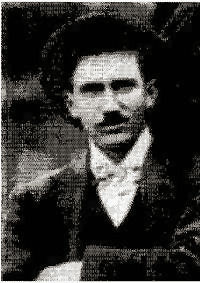
|
|
Originally from Victoria, Louisa was the daughter of
James (a herdsman) and Frances (née Ahern) O’Neill who,
after their wedding in Beechworth on 24 April 1869,
lived in Stanley, a small country town in Victoria about
six miles from Beechworth in the county of Bogong. There
they raised a large family: Bernard (b. 1870), Louisa
(b. 1872), Alice Isabella (b. 1874; d. 25 May 1951),
Mary (b. 1876; bur. 12 February 1877, aged 8 months),
Catherine (b. 1878, known as Kate), Frances, James (b.
1883), John (b. 18 October 1885; d. 14 January 1960),
Agnes Ellen (b. 1888), Annie, and Joseph Henry.
For some years James Franklin and his wife resided in
George Street, Annerley, before moving to Wellington
Road, East Brisbane, where Louisa conducted a small
business. Sadly, a month after their eleventh wedding
anniversary, Louisa died suddenly on 14 February 1912 at
the age of 40 while seated at the breakfast table. At
the time of her death she and her daughters were staying
with her sister Alice Isabella in Chiltern Valley, a
small gold-mining town, in the county of Bogong (in the
shire of Rutherglen) about 20 miles from Wodonga, not
far from her childhood home. More details of this family
tragedy will be included later.
James Franklin Grenier died 6 April 1935 at the
residence of his daughter Edna Taylor, Margaret Street,
Yeerongpilly, and after a service two days later in the
Mary Immaculate Church, Annerley, was buried in the
Cooper’s Plains Cemetery. Father Bernard O’Shea of the
Catholic Church conducted the funeral rites in the
presence of J Dibble and J Dunstan (witnesses). |
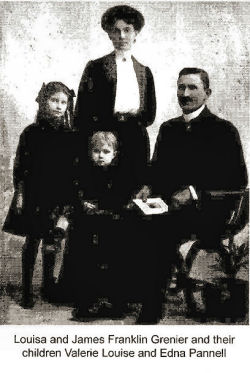 |
|
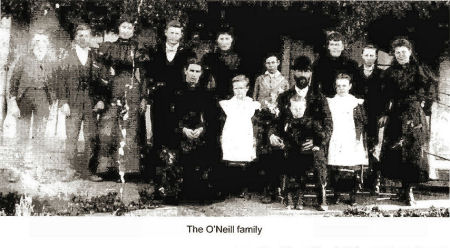
The following obituary (the reference for which has so
far eluded the present writer) will give the reader some
idea of James’s background, his working life and his
interests:
MR. JAMES FRANKLIN GRENIER died at Yeerongpilly on April
6. He was a grandson of the late Mr. Thomas Grenier, one
of the earliest settlers in the Oxley district, and a
son of the late Mr. G. A. Grenier. Born in Oxley 66
years ago, he joined the staff of the Union Bank. After
serving in Brisbane and Rockhampton he became the chief
teller in the Brisbane office, but resigned after 14
years’ service to take up a position with Smellie and
Co., Brisbane. Later he entered the employ of Foggitt,
Jones, Pty., Ltd., at Oxley, retiring four years ago. As
a young man he was a keen cyclist and a player for the
old Oxley Football Club, and he rode several mounts in
the old Oxley race meetings. He leaves one daughter,
Mrs. B. R. L. Taylor, of Margaret-street, Yeerongpilly.
One daughter, Mrs. Leslie Browning, of Oxley, died six
years ago. There are three grandchildren. Messrs. E. P.
Grenier, Land Commissioner at Toowoomba; R. C. Grenier,
police magistrate at Cairns; and Mr. W. P. Grenier,
Crown Lands Ranger at Cunnamulla, are brothers. Mrs. D.
S. Cameron, of Moorooka, is a sister. The late Mrs.
Wallace, wife of Dr. R. Wallace, of Rosewood, was
another sister.
|
|
James Franklin and Louisa’s line continues through their
two daughters. Edna Pannell Grenier (b. 11 August 1908;
d. 14 July 1985) who married Basil Rupert Lyndhurst
Taylor (b. 27 July 1906; d. 3 May 1971), the son of John
James and Lillian May (née Tregurtha) Taylor, on 25
February 1932. They raised three daughters—Barbara Mary
(b. 16 September 1935), Marie Valerie (b. 21 August
1937) and Joy Louise (b. 22 October 1944).
Valerie Louise Grenier (b. 20 October 1902) married
William Leslie Browning (b. 16 December 1901, known as
Les), the son of William Leslie and Margaret (née Sammon)
Browning, on 17 March 1925. Their three children were:
Patricia Margaret (b. Palmwoods, 21 July 1925; d. 22
July 1939), Lionel James (b. Palmwoods, 2 September
1926, known as Boy; m. Catherine Ruby Hale 17 March
1951), and Mary Valerie (b. 18 January (or 28?) 1928,
known as Billie or, as she preferred, Val; m. Robert
Joseph Ryan 22 April 1946; d. 1 February 1976). Valerie
Louise died from complications in childbirth on 19
January 1928 and was laid to rest in the Toowong
Cemetery on the following day in a grave (7A 226A 2)
that would later receive the remains of her eldest
daughter and her husband.
Les Browning remarried on 12 April 1939, this time to
Ellen Kathleen Sheehan (b. 8 November 1904), the
daughter of James Herbert and Sophia (née Hasted)
Sheehan. He passed away full of years and was buried on
27 November 1989. Ellen Kathleen died in the Villa Maria
Hostel, St Paul’s Terrace, Brisbane, and was laid to
rest in the family plot in the Toowong Cemetery (7A 226A
1) on 13 December 1994 aged 90 years.
|
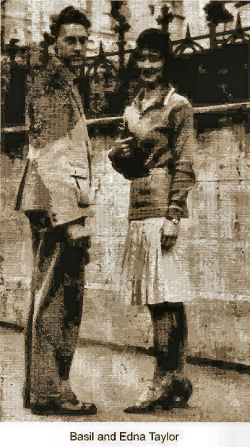 |
|
Louisa Grenier
separated from her husband and returned with her
children to the scenes of her childhood. The following
obituary, which appeared in the Ovens and Murray
Advertiser, records her passing:
DEATH OF A STANLEY NATIVE.¾The
many friends of Mrs. James O’Neill, of Stanley, will
regret to hear that one of her daughters, Mrs. Grenier,
of Queensland, died somewhat suddenly yesterday
(Wednesday) at Chiltern Valley, where she had been
visiting her sister, Mrs. Rosengreen [Alice Isabella].
For some time the deceased had resided in Brisbane, but
having suffered somewhat in health she came over to
Stanley on a visit to her mother, hoping to recruit
[i.e. to gather strength]. About a fortnight ago she
proceeded to Chiltern Valley, but yesterday (Wednesday)
a telephone message from that township conveyed the
painful intelligence that she had died from heart
trouble. Deceased was of a bright, cheerful disposition,
and commanded a large circle of acquaintances, by whom
she was very much esteemed. Among her sisters are Mrs
Rosengreen (2) of Chiltern Valley, Nurse O’Neill, of the
Beechworth Hospital, Miss Alice O’Neill, of Stanley, and
her brothers are Cr. B. O’Neill, and Messrs. John and
Joseph O’Neill, all of Stanley, and Jas. O’Neill of New
Zealand. Mrs. Grenier leaves two children of tender
years to lament the loss of a devoted mother. The
heartfelt sympathy of the whole community is extended to
the O’Neill family in their sad bereavement.
Louisa’s death certificate records that she was treated
on the previous day by Dr CF Harkin, that she had been
ill for six months, that her death from ‘syncope and
rheumatic endocarditis’ was notified by her
brother-in-law, Herman Rosengren [sic], and that she had
lived for 26 years in Victoria and for 14 years in
Queensland. Her remains were taken to the Stanley
Cemetery and were interred on 16 February 1912. With the
assistance of the undertaker, Walter J Edwards, the
committal service was conducted according to the rites
of the Roman Catholic Church by Father Timothy Healy.
After their mother’s death, the two daughters, Edna and
Valerie, returned to Brisbane with their father.
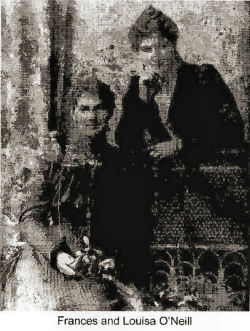
|
|
Ernest Pannell Grenier
Gertrude
Daisy Grenier |
|
Ernest Pannell Grenier,
the son of George Alexander and Sarah Mary Agnes (née
Greenwood) Grenier, was born on 4 April 1876. He married
Gertrude Daisy Hook at the Presbyterian Manse, in
the Brisbane suburb of Sherwood on 20 June 1900. The
presiding minister was the Reverend John Stewart
Pollock; and the witnesses were the groom’s brother
George Alexander Grenier Jr and his sister Sarah Lilly
Grenier.
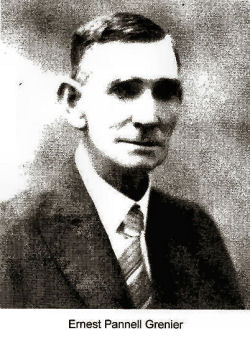
According to the marriage certificate, Gertrude Daisy
Hook was born at Oakvale near Bingara in New South Wales
and was aged 22 years at the time of her wedding. Her
parents were James Henry (a drover) and Annie (née
Cornie) Hook.
Ernest died in the Myles Private Hospital, Arthur
Street, Toowoomba on 26 November 1943. Father James D
Kelly of the Roman Catholic Church conducted the funeral
service at which J McGuinness and AH Simons were
official witnesses.
The following notice appeared in the Toowoomba
Chronicle:
GRENIER.¾The
funeral of the late ERNEST PANNELL GRENIER, of 99
Lindsay Street, Toowoomba, will move from the Mary
Immaculate Church, Ipswich Road, Brisbane, THIS DAY
(Saturday) at 2.30 p.m. for interment in the Grenier
family plot, Cooper’s Plains Cemetery. Private
interment; no flowers. T. S. BURSTOW, Funeral Director.
An obituary which appeared in the in the same newspaper
will give some idea of Ernest Pannell Grenier’s career
as a public servant:
MR. E. P. GRENIER
The death occurred at a private hospital in Toowoomba on
November 26 of Mr. E. P. Grenier, formerly a Land
Commissioner at Toowoomba and district for eight years.
Mr. Grenier, who came of an old Queensland family, was
born at Oxley at his father’s property, “The Willows.”
He was educated at the Christian Brothers’ College,
Gregory Terrace. Joining the Lands Department he
subsequently became Lands Commissioner at Clermont,
Dalby, Maryborough and Toowoomba and district. Deceased
leaves a wife and a son-in-law and daughter, Major and
Mrs. J. A. Cran, and one grandson, Peter Cran; also a
sister, Mrs. D. S. Cameron, of Brisbane, and two
brothers. One brother, Mr. W. P. Grenier, is attached to
the Land Office in Gayndah, and another brother, Mr. R.
C. Grenier, is stipendiary magistrate at Bundaberg.
After her husband’s death Gertrude Daisy Grenier moved
to the Brisbane suburb of Wilston where she lived with
her daughter Jeanne Alexandra Cran. She passed away on
13 May 1950 and was buried in the Cooper’s Plains
Cemetery two days later. The Reverend Theo C Kernke of
the Church of England conducted the service at which the
two witnesses were J Overend and E White.
Sadly, Ernest Pannell and Gertrude Daisy’s other
daughter, Gertrude Mary, died on 16 May 1910, five days
after her birth, and was buried in the Atherton
Cemetery, North Queensland.
|
|
|
Reginald Courtenay Grenier |
|
Reginald Courtenay Grenier,
the youngest of the large family of George Alexander and
Sarah Mary Agnes (née Greenwood) Grenier, was born on 27
February 1882. His arrival was announced in the
Queenslander, the weekly edition of the Brisbane
Courier. The given name ‘Courtenay’ may have been
inspired by the fact that Captain Thomas and Margaret
(née Orr) Boyland, close friends of the Grenier’s at
Oxley Creek, had a son called Courtney who married
Margaret Byers on 14 April 1891. At least nine members
of the Boyland family are buried in God’s Acre,
including Thomas and Margaret.
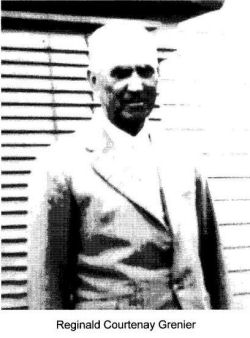
Reginald Courtenay Grenier completed his schooling at St
Joseph’s College, Gregory Terrace, Brisbane between 1895
and 1898. Newspaper reports of the school’s annual prize
distribution evenings in the Centennial Hall indicate
that he was awarded a prize in sixth class for general
efficiency and mathematics in 1896 and for English and
geography in the junior university (2nd division) class
in 1897. He passed the junior university (class A)
examination in 1898 and, like the other successful
candidates from his school, he received a silver medal
to mark his achievement.
Reginald married Mary Mildred Fisher on 6 April
1918. Mary was the daughter of Alfred John and Matilda
(née Johnston) Fisher who were themselves married on 27
February 1875.
The children of the Fisher family were as follows: Emily
Grace (b. 21 January 1876), Alice Evelyn (b. 11 August
1877), George Alfred Handcock (b. 31 March 1879), Edith
Jane (b. 23 September 1880), Thomas Frederick (b. 1
September 1882), Charles Percy (b. 23 January 1884),
Mary Matilda (b. 19 October 1885), Lily Ann (b. 18 July
1888; d. 7 September 1888), Ellen Frances (b. 7 May
1890).
Reginald Courtenay Grenier’s career is summarised in a
number of obituaries which appeared in Queensland
newspapers. In the pages of the Maryborough Chronicle
and Gympie Times respectively we read:
MR. R. C. GRENIER.¾The death
occurred recently of Mr. Reginald C. Grenier, of Yundah-street,
Shorncliffe, a seaside resort of Brisbane. Mr. Grenier
was a retired Stipendiary Magistrate. He joined the
public service in 1900 and served in various petty
session offices throughout Queensland as a clerk and C.
P. S. He was first appointed a Magistrate at Charleville
in July, 1925, and was transferred to Bundaberg in 1941,
and then to Gympie where he retired in February, 1947.
While in Bundaberg Mr. Grenier, in addition to his
Magisterial duties, fulfilled the position of chairman
of the local Cane Prices Board and chairman of the
Bundaberg Hospitals’ Board. His passing will be
regretted by a large circle of friends. Mr. Grenier was
stationed at Maryborough many years ago as C. P. S.
Mr. Reginald Courtenay Grenier, retired stipendiary
magistrate who for some years held that position at the
Gympie Court House, died in a Brisbane private hospital
on Wednesday. Mr. Grenier, who was 66 years of age,
retired from the public service some 20 months ago, his
position in Gympie being the last which he held. After
retirement he took up residence at Shorncliffe. Mr.
Grenier’s health had been poor for several months before
his demise. Deceased is survived by his wife, Mrs. Mary
Grenier, and two daughters, Mrs. J. L. Merrotsy of
Murwillumbah and Miss Maria [Estelle Marie] Grenier of
Shorncliffe.
While he was Clerk of Petty Sessions in Maryborough,
Reginald was called upon to give evidence on Monday, 20
January 1919, at the Royal Commission on the
Classification of Officers in the Public Service. In a
document which points to an efficient man very much in
touch with his duties, he lists his subsidiary positions
as follows: Registrar of the District Court, Electoral
Registrar for Maryborough and Wide Bay, Registrar of the
Small Debts Court, Registrar of Pensions, Registrar of
Firms, Assistant Immigration Agent, Receiver of Taxes,
Agent for the Insurance Commission, Agent for the Public
Curator, Deputy Sheriff, and Justice Appointed to hold
Inquiries under the Insurance Act. His salary was then
in the £250-270 range.
Reginald Courtenay Grenier died in the Turrawan Private
Hospital, Clayfield, on 3 November 1948. On the
afternoon of Friday, 5 November 1948, after prayers at
the Mary Immaculate Church, Annerley, his remains were
laid to rest in the family plot in the Cooper’s Plains
Cemetery at Archerfield. Father T Fitzgerald presided at
the burial service in the presence of G Hughson and WH
White (witnesses).
Reginald’s widow Mary moved to Murwillumbah in northern
New South Wales where, having been cared for by their
younger daughter, she died in 1973. She was buried in
the Tweed Heads Cemetery.
This family line continues through two daughters.
Estelle Marie (b. 28 January 1920) married Kevin Julian
Leahy at St Agatha’s Church, Clayfield on 18 August 1949
with Monsignor John English presiding; and Alison
Margaret (b. 27 August 1921) married John Leslie
Merrotsy at the Cathedral of St Stephen on 15 August
1943.
Estelle Marie Grenier (QFX49750) enlisted in the
Australian Army Medical Women’s Service (AIF) on 3 March
1943, soon after its formation, and served until she was
discharged on 14 June 1946.
|
|
William Leichhardt Grenier
Mary Jane Grenier
Olive Vera Grenier |
|
William Leichhardt Grenier,
the youngest son of Thomas and Mary (née Pannell)
Grenier, was born on 13 December 1854 and was christened
in St John’s Church by the Reverend Robert Gregory
Creyke on 6 July 1855. His second given name recalls the
memory of the celebrated German explorer, Ludwig
Leichhardt, whose fateful second expedition into the
heart of the colony had resulted in his death about a
decade earlier.
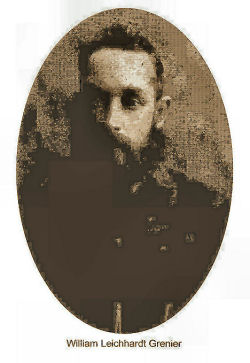 |
|
Leich (as he was commonly known) married 19-year-old
Mary Jane Catchpole, the daughter of George and
Maria (née Balaam) Catchpole, in St Matthew’s Church,
Oxley, according to the rites of the Church of England
on 29 May 1878. The officiating minister was the
Reverend James Samuel Hassall and the witnesses were
Charles Catchpole, the bride’s brother, and Sarah Louisa
Catchpole, her elder sister.Leich and Mary Jane raised four daughters and one son:
(Ethel Jane b. 22 June 1879; d. 29 June 1965), Sidney
Leichhardt (b. 9 August 1881; d. 10 February 1955), Ivy
Mary (b. 14 August 1885; d. 16 August 1960), Myrtle
Sarah (b. 20 June 1888; d. 25 May 1969) and Olive Vera
(b. 6 April 1899; d. 16 July 1980).
Details of their marriages are as follows. Ethel Jane
married John Daniel Jackson Vine on 27 November 1909.
Sidney Leichhardt married Irish-born Isabella Armstrong,
the daughter of Thomas and Elizabeth (née Fee) Armstrong
on 29 July 1904. Ivy Mary Grenier married Richard Baron
Howard on 14 August 1912. Myrtle Sarah Grenier married
Thomas Mellers at St Mary’s Church, Kangaroo Point, on
20 August 1913. Olive Vera Grenier, an accomplished
musician and music teacher, never married.
William Leichhardt Grenier, a dairy farmer for many
years, died on 16 September 1930 aged 73 and was laid to
rest in the Cooper’s Plains Cemetery, God’s Acre, on the
following day. Those who exercised official roles in the
interment were: RA Gow (undertaker), the Reverend B
Arthur Arnold of the Church of England, A Thompson and H
Horsham (witnesses).
|
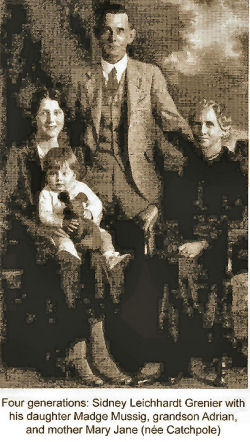 |
|
The following obituary of William Leichhardt Grenier
appeared in the Queenslander and the Brisbane
Courier:
The death of Mr. William Leichhardt Grenier at his
residence, Hansen-street, Moorooka, on September 16,
removes another native of Brisbane, and incidentally the
last member of the family of the late Thomas Grenier,
who, in the early days, was one of Brisbane’s leading
citizens, being an alderman on the Brisbane Municipal
Council, 1867-8. With his wife and one child [three
children] Mr. Thos. Grenier arrived in Sydney in the
year 1839 from Sussex.
From Sydney they went to New Zealand. The Maori uprising
in 1841, and the burning of their home by the Maori
chief, Hongi [Hone] Heke, caused them to migrate again
to Sydney, leaving there for Brisbane in 1845. For many
years he conducted Grenier’s Inn, the only hotel of note
in South Brisbane. He later acquired the property known
as the Willows, on Oxley Creek, where he developed an
ideal home, and engaged in cotton and maize growing and
dairying. The late Mr. W. L. Grenier was born at his
father’s hotel in South Brisbane in the year 1854, and
was named after the intrepid explorer, Leichhardt, whose
last fateful expedition started in the vicinity of his
parents’ home. He was buried in the Cooper’s Plains
Cemetery, which his father established 71 years ago for
the use of his family and residents of the district. The
Reverend B. A. Arnold, parish priest, conducted the
service at his home, and at the graveside. The
pall-bearers were his only son (Mr. S. L. Grenier), his
eldest grandson (Mr. Tom Grenier),
and sons-in-law (Messrs. J. D. Vine and T. Mellers). He
is survived by his widow and five children (Mr. S. L.
Grenier, Miss 0. Grenier, and Mrs. J. D. Vine, Moorooka,
Mrs. R. B. Howard, Toowoomba, and Mrs. T. Mellers,
Toowong), and fifteen grandchildren. He was popular and
highly respected by all who knew him, and was noted for
his genial nature.
Mary Jane Grenier,
who was a first-day pupil at the Oxley State School,
passed away on 6 August 1946 at her Hansen Street,
Moorooka, residence. She was laid to rest beside her
husband two days later in a service at which the
following were present in an official capacity: George
Hartnett (undertaker), the Reverend B Arthur Arnold of
the Church of England, G Hughson and JK Armstrong
(witnesses). |
|
Olive Vera Grenier,
the youngest of the children of William Leichhardt and
Mary (née Catchpole) Grenier and the youngest of the 41
grandchildren of Thomas and Mary Grenier, passed away in
the Princess Alexandra Hospital on 16 July 1980. Her
funeral left from St Mary’s Church of England, Moorooka
on 21 July for what her death notice describes as ‘the
Grenier private Family Cemetery, Archerfield (Founded by
the late Thomas Grenier)’. The Reverend John Parton
conducted the graveside service.
Olive, a talented music teacher, lived with her parents
in the family home in Hansen Street, Moorooka. She never
married. |
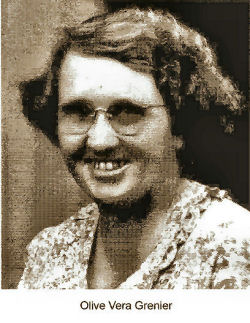 |
|
Sidney Leichhardt Grenier
Isabella Grenier |
|
Sidney Leichhardt Grenier,
the second eldest of the children of William Leichhardt
and Mary Jane (née Catchpole) Grenier, was born on 9
August 1881. He grew up at Sutton Street, Kangaroo
Point, and for a time attended St James’s School in
Boundary Street, Spring Hill. His teacher there, whom he
fondly remembered, was Irish-born Brother William Joseph
Hogan (1863-1942).
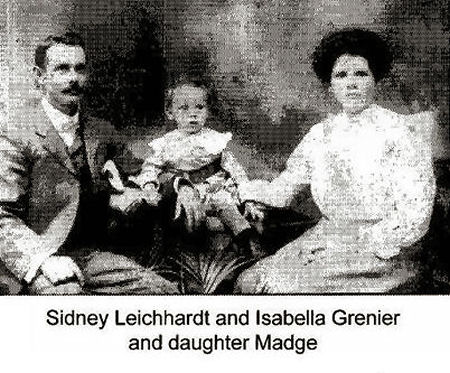 |
|
Sid was employed for many years in the Brisbane Tramway
Company. His strong left-wing political stance was
reinforced by his involvement in the Great Tramways
Strike of 1912. The General Manager at that time was an
American, Joseph Stillman Badger (1881-1934), who was
opposed to trade unionism and who decreed that union
badges were not to be worn by men on duty.
As noted above, Sid married Irish-born Isabella
Armstrong, the daughter of Thomas (a farmer) and
Elizabeth (née Fee) Armstrong, on 29 July 1904.
Described on his death certificate (a little generously)
as a ‘retired mechanical engineer’, he died on 10
February 1955 in the Mater Misericordiae Public
Hospital, South Brisbane, aged 73 years. He was laid to
rest in the Cooper’s Plains Cemetery on the following
afternoon after a service in St Mary’s Anglican Church,
Hamilton Road, Moorooka. Assisting the burial in an
official capacity were: George Hartnett (undertaker),
the Reverend DC Gooderham (Church of England), P Fursey
and WH White (witnesses).
Sid and Bella raised three sons and two daughters:
Sidney William Leichhardt (b. 2 October 1904, known as
Tom; m. Catherina Kearney 6 June 1931; d. 19 January
1974), Marie Isabel (b. 8 July 1906; m. George Curley 7
July 1928; d. 5 September 1989), Madge (b. 21 April
1908; m. Francis William Mussig 28 July 1928; d. 2 May
1992), Jack Franklin (b. 30 May 1916; d. 1 August 1992)
and Raemond Volney (b. 20 January 1923; d. 16 May 1992).
Isabella Grenier
was born in Drumbulkin, County Fermanagh, Ireland on 12
November 1878 (IGI).. She travelled to Australia
with her sister Sarah who married Robert Dempster on 5
March 1907 and died on 28 April 1956.
Isabella passed away at her residence in Hansen Street,
Moorooka on 9 October 1949. Her burial in the Cooper’s
Plains Cemetery took place two days later in the
presence of W Horsham (undertaker), the Reverend GH
Darke of the Church of England, and J Overend and EW
White (witnesses)
.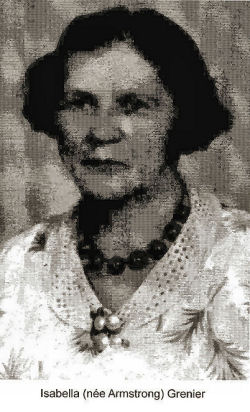
|
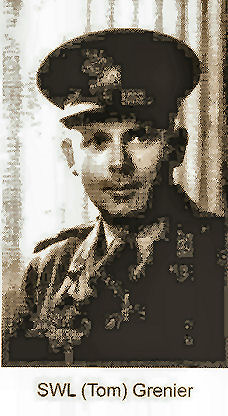
|
|
|
Raemond Volney Grenier |
|
Raemond Volney
(Doc) Grenier, the youngest of the five
children of Sidney Leichhardt and Isabella (née
Armstrong) Grenier, was born on 20 January 1923. He was
a foundation member of the God’s Acre Restoration
Committee.
Ray lived in the family home in Moorooka all his life
and took an active interest in sporting bodies in that
area. As his funeral notices indicate, he was a
foundation and life member and trustee of the Moorooka
Districts Australian Football Club and an active member
of the
Moorooka Bowls Club
Like his two brothers, Jack and Tom, he joined the
Australian Army during World War II.
Ray died on 16 May 1992, mourned by his wife Peggy (née
Parsons) and their son Mark Raymond,
and was cremated at Mount Thompson Crematorium on 20
May.
|
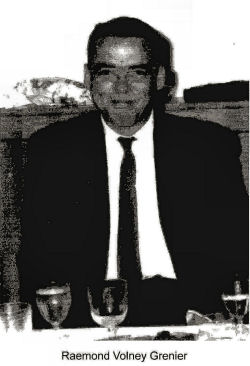
|
|



















